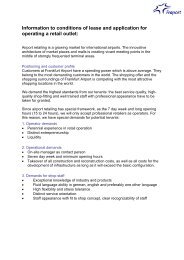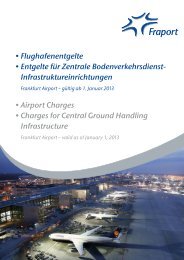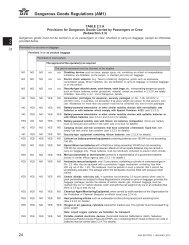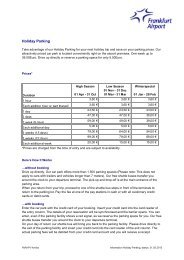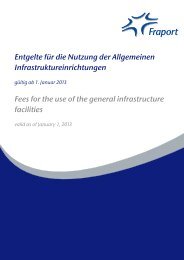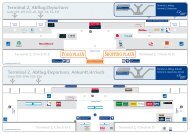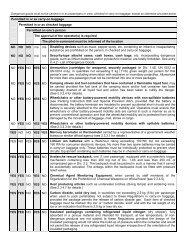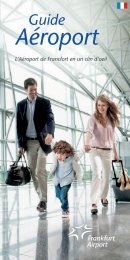Questions and answers - Frankfurt Airport
Questions and answers - Frankfurt Airport
Questions and answers - Frankfurt Airport
You also want an ePaper? Increase the reach of your titles
YUMPU automatically turns print PDFs into web optimized ePapers that Google loves.
<strong>Questions</strong> <strong>and</strong> <strong>answers</strong>: re-adjustment of costrelated<br />
utilization fee (KNE)
<strong>Questions</strong> Summary<br />
1. General information regarding the updated model of the utilization<br />
fees<br />
2. Legal background<br />
3. Calculation pattern (model), cost basis<br />
4. Practical application by user (including basics for airport user<br />
regulations)
General information to re-adjustment of KNE<br />
What is the background of this model?<br />
Why is it introduced?<br />
The cost-related utilization fee (KNE) is no new charge; it was already<br />
introduced at <strong>Frankfurt</strong> <strong>Airport</strong> in 2006 <strong>and</strong> has since been charged. Its<br />
basis is the judgment given by the European Court of Justice allowing<br />
for the levying of a fee for the utilization of airport infrastructures (for<br />
detailed information regarding this judgment, please see Part 2: Legal<br />
background)<br />
A re-adjustment has been made necessary for two reasons: a) the<br />
growth in the number of users <strong>and</strong> b) the refinement of the utilization<br />
intensity on the basis of a turnover portion <strong>and</strong>, additionally an ID<br />
component, which is new.
General information to re-adjustment of KNE<br />
What is new?<br />
As in the past, first of all, the entire annual costs are being calculated for the General<br />
Infrastructures (i.e. streets <strong>and</strong> roads, security operation, transport on our own account,<br />
etc.), then, after definition of all airport users, these costs are allocated to individual user<br />
groups (such as airlines, Fraport itself, ground h<strong>and</strong>lers <strong>and</strong> airport user regulations)<br />
according to corresponding keys. The only aspect that is new is that the providers holding<br />
licensing agreements* are no longer being charged exclusively on the basis of a given<br />
turnover portion, but, additionally, on the basis of the number of ID types they are holding.<br />
Thus, by including the turnover realized at <strong>Frankfurt</strong> <strong>Airport</strong>, not only the effective utilizability<br />
of the General Infrastructures (= access to various infrastructure facilities via the color of ID<br />
cards), will be identified, but the usage intensity will be shown as well.<br />
Former model<br />
will continue<br />
to apply <strong>and</strong><br />
was certified<br />
by audit<br />
Before:<br />
New:<br />
1<br />
2<br />
3<br />
4<br />
4<br />
Definition of cost for General Infrastructur es<br />
(planned for 2013: 53.2 million euros)<br />
Definition of all airport users<br />
Allocation of cost portion to user sectors<br />
Distribution of costs to individual via commercial fee<br />
Cost-sharing by individual users: 50 % based on number<br />
of ID cards/vehicle permits, 50 % via commercial fee<br />
* Where no licensing<br />
agreement is conluded or, in<br />
individual cases, where it is<br />
proven that the turnover<br />
cannot be defined, 100% of<br />
the cost-related utilization<br />
fees will be based on the ID<br />
cards.
General information to re-adjustment of KNE<br />
No change in types of ID cards<br />
The identification system regulations providing for an authorization by Fraport AG for<br />
the access or entry to certain airport areas, will continue to apply. Fraport AG issues the<br />
following airport IDs which serve as proof that access has been authorized:<br />
1. Permanent ID cards <strong>and</strong> vehicle permits<br />
2. Temporary ID cards<br />
3. Temporary vehicle permits<br />
4. Transferable vehicle permits<br />
5. Coded CCS/CCN keycards
General information to re-adjustment of KNE<br />
Future types of ID cards?<br />
1. Permanent ID cards <strong>and</strong> vehicle permits<br />
− (Permanent) personal ID: Personal ID cards are photographic airport ID documents<br />
restricted to individual persons who are employed regularly <strong>and</strong> permanently at<br />
<strong>Frankfurt</strong> <strong>Airport</strong>. There are different colors/types of ID card for different accesses to<br />
<strong>Frankfurt</strong> <strong>Airport</strong>.<br />
− (Permanent) vehicle permit: Vehicle permits are valid for the operation of a vehicle that<br />
is permanently being used at <strong>Frankfurt</strong> <strong>Airport</strong>.<br />
− (Permanent) personal ID with access code: Personal ID card (see above), issued upon<br />
special request (if the rented parking place for a private vehicle is proven). The required<br />
access code is shown on the personal ID card.
General information to re-adjustment of KNE<br />
Future types of ID cards?<br />
2. Temporary ID cards<br />
− Photographic temporary ID card: Temporary ID cards are always restricted to individual<br />
persons <strong>and</strong> have to show the holder‘s photograph. Such cards are issued for persons<br />
that are temporarily employed at <strong>Frankfurt</strong> <strong>Airport</strong> or that have been given a temporary<br />
replacement for their personal ID card (for example, because they have lost it).<br />
One person may be entitled to receive such a temporary access card under the<br />
following conditions:<br />
− 4 x per calendar year for a maximum duration of 14 days for operational area (green ID<br />
card);<br />
− 4 x per calendar year for a maximum duration of 14 days for airside areas with valid<br />
reliability check (ID card color blue, red or yellow);<br />
− 1x per month for a maximum of one day without a valid reliability check with permanent<br />
company by a person who has been checked pursuant to Article 7 of the Aviation<br />
Security Act (holder of a permanent ID card, valid for the area to be entered) for airside<br />
areas (ID card color blue, red or yellow)<br />
A photographic temporary ID card is not subject to cost-related utilization fees
General information to re-adjustment of KNE<br />
Future types of ID cards?<br />
3. Temporary vehicle permit<br />
− Temporary vehicle permits: These permits are valid for the operation of a temporarily<br />
used vehicle or as a temporary replacement for a vehicle permit. The approval applies<br />
for the operation area (green) <strong>and</strong> must be authorized by the ID Cards Service Center,<br />
the Visitors‘ Service or the Airside Duty Management. The application for temporary<br />
vehicle permits for the apron area (red) can only be made at <strong>and</strong> issued by the Airside<br />
Duty Management.<br />
A temporary vehicle permit can be issued 4 times a year for a maximum duration of 14<br />
days for the same vehicle; thereafter a permanent vehicle permanent must be issued<br />
for that vehicle.
General information to re-adjustment of KNE<br />
Future types of ID cards?<br />
4. Transferable vehicle permit<br />
− Transferable vehicle permits (“ÜFG“): These permits are valid for the operation of<br />
various vehicles at <strong>Frankfurt</strong> <strong>Airport</strong> that are driven in rotation or they are issued as a<br />
temporary replacement for a vehicle permit. A transferable vehicle permit is only<br />
available for the operation area (permit color: green).<br />
For the CCS <strong>and</strong> CCN areas, issue of these transferable vehicle permits through the<br />
<strong>Airport</strong> ID Cards Service Center (SCF) is limited exclusively to forwarding agents,<br />
suppliers <strong>and</strong> courier services.
General information to re-adjustment of KNE<br />
Future types of ID cards?<br />
5. Coded CCS/CCN key cards<br />
− Coded CCS / CCN key cards: These are ID cards without a photograph used to open<br />
specific, technologically secured access points in the CCS/CCN area (gates 26, 31 <strong>and</strong><br />
32). They are considered to be a “key“ for the one-time entry <strong>and</strong> do not serve as a<br />
personal or vehicle identification. Coded key cards are not subject to cost-related<br />
utilization fees.<br />
These coded key cards are issued to forwarding agents, suppliers / transportation<br />
service providers / visitors, enabling them to pay short visits or to temporarily deal with<br />
their matters, upon application <strong>and</strong> registration at the above mentioned gates.<br />
Where these users require access or entry to the airport due to a permanent or regular<br />
activity (> 1x per month), their employer (depending on the business model) shall be<br />
bound to apply for a permanent access/entry permit (personal ID card, vehicle permit,<br />
transferable vehicle permit) <strong>and</strong> possibly to conclude a licensing agreement.
General information - Prices for cost related<br />
utilization fees as from January 1st, 2013<br />
How much do the ID cards <strong>and</strong> permits cost?<br />
− The costs for the types of ID cards (green, blue, red, yellow) <strong>and</strong> for the vehicle permits<br />
(green, red, green transferable) were fixed on July 1st, 2012. These cards authorize the<br />
access to various areas on the airport premises <strong>and</strong>, thus, allow the utilization of<br />
different infrastructures. This results in varying values <strong>and</strong>, consequently, in different<br />
prices.<br />
Yearly costs for ID cards (proportionate settlement to be done monthly) WITHOUT turnover<br />
declaration<br />
(100%)<br />
Personal ID card, green 356.00 €<br />
Personal ID card, blue, red, yellow 591.00 €<br />
Personal ID card, green with entry code to operation area 582.00 €<br />
Personal ID card, blue, red, yellow with entry code to operation area 817.00 €<br />
Vehicle permit, green 226.00 €<br />
Vehicle permit, red 1,643.00 €<br />
Transferable vehicle permit, green 582.00 €<br />
− The above prices apply whenever NO turnover is taken into consideration for their<br />
determination<br />
see part 3: calculation pattern (model)
General information to re-adjustment of KNE<br />
Future development of prices for the costrelated<br />
utilization fee<br />
Will the prices stay?<br />
− The prices for the ID cards <strong>and</strong> vehicle permits result from the annual costs for General<br />
Infrastructures <strong>and</strong> from the number of ID cards / vehicle permits issued (<strong>and</strong> are also<br />
dependent on the number of users per group). Should one of these quantities change<br />
substantially, the prices for ID cards <strong>and</strong> vehicle permits will have to be adjusted.<br />
− However, the cost-related utilization fee is strictly reflecting the actual cost, i.e. Fraport<br />
does not generate any profit but only distributes the costs incurred to all the users,<br />
including to Fraport itself.
General information to re-adjustment of KNE<br />
First-time participation of all users?<br />
− Already today, 90% of the costs are charged <strong>and</strong> paid with due regard to the actual<br />
proportions. Yet, this does not correspond to 90% of users, since especially the cargo<br />
area had been exempted in the past.<br />
− The previous discrepancy between the actual annual costs for General Infrastructures<br />
<strong>and</strong> the amount charged to the users has so far been borne by Fraport AG (in the non-<br />
regulated area). Fraport AG, just like the other users, is already participating in the<br />
maintenance of General Infrastructures due to the amount allocated to it.
Legal background (1)<br />
On October 16, 2003 the European Court of Justice declared access fees to the market to<br />
be inadmissible, yet confirmed the right to levy a fee for the utilization of airport-based<br />
infrastructures, provided that it be charged in connection with the costs incurred.<br />
Consequently, Fraport AG determined the actual costs on which such an utilization is based<br />
<strong>and</strong> adjusted the utilization fee in conformity with the ECJ judgment as per January 1st,<br />
2006. In addition, the corresponding cost basis has recently been confirmed by an audit<br />
opinion. Therefore, the cost-related utilization fee is a justified <strong>and</strong> legal charge.
Legal background (2)<br />
Ruling of the European Court of Justice :<br />
Council Directive 96/67/EC of October 15, 1996 on access to the groundh<strong>and</strong>ling market<br />
at Community airports, especially to Article 16 (3) – precludes the managing body of an<br />
airport from making access to the groundh<strong>and</strong>ling market in the airport subject to payment<br />
by a third-party supplier of groundh<strong>and</strong>ling services or a self-h<strong>and</strong>ler of an access fee as<br />
consideration for the grant of a commercial opportunity, in addition to the fee payable by<br />
that supplier or self-h<strong>and</strong>ler for the use of the airport installations.<br />
On the other h<strong>and</strong>, that body is entitled to collect a fee for the use of airport installations, of<br />
an amount, to be determined according to the criteria laid down in Article 16 (3) of the<br />
Directive, which takes account of the interest of that body in making a profit.<br />
Therefore, a fee for the utilization of airport infrastructures is admissible. The cost-related<br />
utilization fee is such a fee, because this does not result in Fraport making a profit; the<br />
managing body only passes on the costs to the users.
2. Legal background<br />
Double payment of public roads through trade<br />
tax?<br />
For some parts of the public roads in the airport area, Fraport is responsible for public<br />
safety. Therefore, the corresponding costs are unrelated with the trade tax to be paid to the<br />
public sector.
2. Legal background<br />
Double payment, as compensated by building<br />
lease?<br />
Cost-sharing via the development costs <strong>and</strong> the l<strong>and</strong> charge does, for a large part, not<br />
cover the expenses for the utilization of infrastructure facilities.<br />
In most cases, the building lease only defines the connections to the airport‘s internal road<br />
system. As examples, security operation <strong>and</strong> the transport on our own account do not form<br />
part of the l<strong>and</strong> charge; they are, therefore, not reflected in the lease <strong>and</strong> had not been paid<br />
for in the past.<br />
Since building leases are individually set up, it is jointly checked whether any portions are<br />
already being compensated <strong>and</strong>, in the affirmative, which they are. These portions would<br />
not be taken into consideration in the cost-related utilization fee.
2. Legal background<br />
Are co-tenants also affected? Do tenants need<br />
to pay the cost-related utilization fee, even when<br />
not contractually bound to Fraport?<br />
Yes* – the lawfulness of this fee is independent from any contractual relation between<br />
Fraport AG <strong>and</strong> the user of the infrastructures at <strong>Frankfurt</strong> <strong>Airport</strong>. The decisive element is<br />
that those using the infrastructure facilities be also involved in cost-sharing.<br />
* This might depend on individual building lease agreements
3. Calculation pattern (model), cost basis<br />
Cross-subsidy of non-payers?<br />
Were non-payers previously financed by others?<br />
The users that were paying their share in the past, did not cross-subsidize non-payers! The<br />
shortfall had been borne by Fraport AG (in the non-regulated area).
3. Calculation pattern (model), cost basis<br />
Fraport‘s share of cost-related utilization fees?<br />
Does Fraport also pay such fees?<br />
Since the very introduction of the cost-related utilization fee on January 1st, 2006, both<br />
Fraport AG <strong>and</strong> all its subsidiaries <strong>and</strong> investments have been taken into account when<br />
calculating the cost-related utilization fee. Just as it has been the case with the other user<br />
groups at <strong>Frankfurt</strong>, Fraport has been charged its share of costs attributable to General<br />
Infrastructures on the basis of a corresponding scheme. The updated model will not affect<br />
this.
3. Calculation pattern (model), cost basis<br />
Varying usage intensity: Why is there no finer<br />
adjustment?<br />
The various types of ID cards/colors grant the right of access to different areas on the<br />
airport premises <strong>and</strong> to use various infrastructure facilities. Thus, the principle of causation<br />
is fully taken into account.<br />
A further graduation of the ID cards for the utilization of individual services (for example the<br />
separate treatment of bussing) would result in higher administrative costs (<strong>and</strong><br />
consequently also in increased costs for General Infrastructures); besides it would be very<br />
difficult to implement logistically.
3. Calculation pattern (model), cost basis<br />
Why not just on the basis of the number of ID<br />
cards?<br />
Thanks to the new calculation pattern (50 % based on the number of ID cards <strong>and</strong> 50 % via<br />
a commercial fee) not only the actual usability of General Infrastructures (= access to<br />
various infrastructure facilities as per color of ID card) is identified, but the intensity of usage<br />
is shown as well (= by including the turnover-based commercial fee).<br />
The principle of causation is complied with even better by the symbiosis between potential<br />
utilization <strong>and</strong> the intensity of usage.<br />
In cases where users prove that they cannot put an exact figure on turnover, they shall pay<br />
100% of the ID card cost portions.<br />
For prices, see Part 1: General
3. Calculation pattern (model), cost basis<br />
No turnover figures possible? What happens<br />
when someone does not report turnover?<br />
If a service provider does not report to Fraport AG their turnover figures (always by the 15th<br />
of the following month) the share in the cost-related utilization fee will be taken to be 100%<br />
of the number of issued ID cards / vehicle permits.<br />
For prices applicable for a 100% payment on the basis of ID cards, see Part 1: General
4. Practical application by users (incl. FBO<br />
basis)<br />
Definition of the turnover to be reported?<br />
“Turnover“ is deemed to be the sum total of all supplies <strong>and</strong> services provided on the airport<br />
premises, reflected in a licencing agreement <strong>and</strong> not compensated by the airport user<br />
regulation (FBO) or other fees.
4. Practical application by users (incl. FBO<br />
basis)<br />
What is the exact settlement <strong>and</strong> invoicing<br />
procedure?<br />
The amount of the cost-related utilization fee will be billed by the 15th of the following<br />
month proportionally to the previous month.<br />
This calculation <strong>and</strong> settlement will take into account the exact figures of the month; in the<br />
event that an ID card/vehicle permit was returned during the year, no payment will be made<br />
in the month following the return.<br />
The entire monthly turnover will continue to be reported to Fraport AG by the 15th of the<br />
following month (100%). Yet, the future invoices will only reflect 50% of the turnover portion<br />
at the applicable rate of assessment – additionally to the billing prices for ID cards (50% of<br />
the ID card prices mentioned in Part 1: General)



